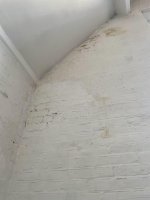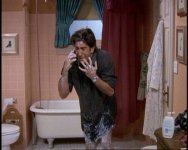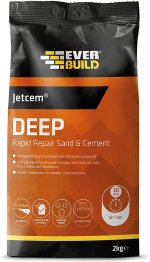Associate
- Joined
- 19 Aug 2019
- Posts
- 257
It began simply. All I wanted to do was give the walls a lick of paint.
I knew there was damp ....

but I also knew that it wasn't going to get fixed for at least a year (money, freehold, scaffolding etc etc). But the look of it bothered me so I thought I'd just scrape the walls as best I could, put down a waterproof primer and then paint away.
However when I began scraping rather a lot of the wall came away.

I thought I'd put on some "mortar stabiliser" and then some waterproof masonry primer anyway.
This somewhat aggravated the situation.


All in all I was feeling a bit like this:

I persevered.
I decided it was worth taking out some of the mortar on the really bad bits and then repointing; else I don't think I was going to be able to paint over the areas because of the crumbling mortar.
I used this stuff at first. In the video below it's the grey stuff on the wall.

But it dried very very hard so it might not have been right. However, I didn't use a lot of it because I ran out.
Then I used an actual mortar mix that I got from the trade building shop near me. I filled in most of the holes but I'm a bit concerned that I didn't mix it right because it seems very crumbly to me.

SO I did that and now I'm sort of half way done but there is more crackling yellowing paint in other areas and I wanted to ask what the best course of action would be. I know that I need to find and fix the leaks but that just isn't going to happen for a while (for reasons above). I don't want to make it any worse and I thought perhaps there was something I could do from inside that might at least help a bit.
Here is a video that may make you feel a bit seasick bc I'm up a ladder.
Also I wanted to check that I wasn't doing anything terribly terribly wrong.
Meanwhile, I want to paint the rest of the place but I know I'm going to have to clean or at least brush the surfaces first and I'm worried that if I do, a LOT of wall will come off.
This is my story.
I knew there was damp ....

but I also knew that it wasn't going to get fixed for at least a year (money, freehold, scaffolding etc etc). But the look of it bothered me so I thought I'd just scrape the walls as best I could, put down a waterproof primer and then paint away.
However when I began scraping rather a lot of the wall came away.

I thought I'd put on some "mortar stabiliser" and then some waterproof masonry primer anyway.
This somewhat aggravated the situation.


All in all I was feeling a bit like this:

I persevered.
I decided it was worth taking out some of the mortar on the really bad bits and then repointing; else I don't think I was going to be able to paint over the areas because of the crumbling mortar.
I used this stuff at first. In the video below it's the grey stuff on the wall.

But it dried very very hard so it might not have been right. However, I didn't use a lot of it because I ran out.
Then I used an actual mortar mix that I got from the trade building shop near me. I filled in most of the holes but I'm a bit concerned that I didn't mix it right because it seems very crumbly to me.

SO I did that and now I'm sort of half way done but there is more crackling yellowing paint in other areas and I wanted to ask what the best course of action would be. I know that I need to find and fix the leaks but that just isn't going to happen for a while (for reasons above). I don't want to make it any worse and I thought perhaps there was something I could do from inside that might at least help a bit.
Here is a video that may make you feel a bit seasick bc I'm up a ladder.
Also I wanted to check that I wasn't doing anything terribly terribly wrong.
Meanwhile, I want to paint the rest of the place but I know I'm going to have to clean or at least brush the surfaces first and I'm worried that if I do, a LOT of wall will come off.
This is my story.
Last edited:



 expensive) for us to do the roof. Prohibitively so. It needs scaffolding and the whole building needs to be done (three flats) so we're waiting until we get the freehold so we can get people in who don't get picked by the freeholder and are, thus, cheaper. But it won't be for a while. I just wanted it to look nicer. IS THAT SO BAD??????
expensive) for us to do the roof. Prohibitively so. It needs scaffolding and the whole building needs to be done (three flats) so we're waiting until we get the freehold so we can get people in who don't get picked by the freeholder and are, thus, cheaper. But it won't be for a while. I just wanted it to look nicer. IS THAT SO BAD??????